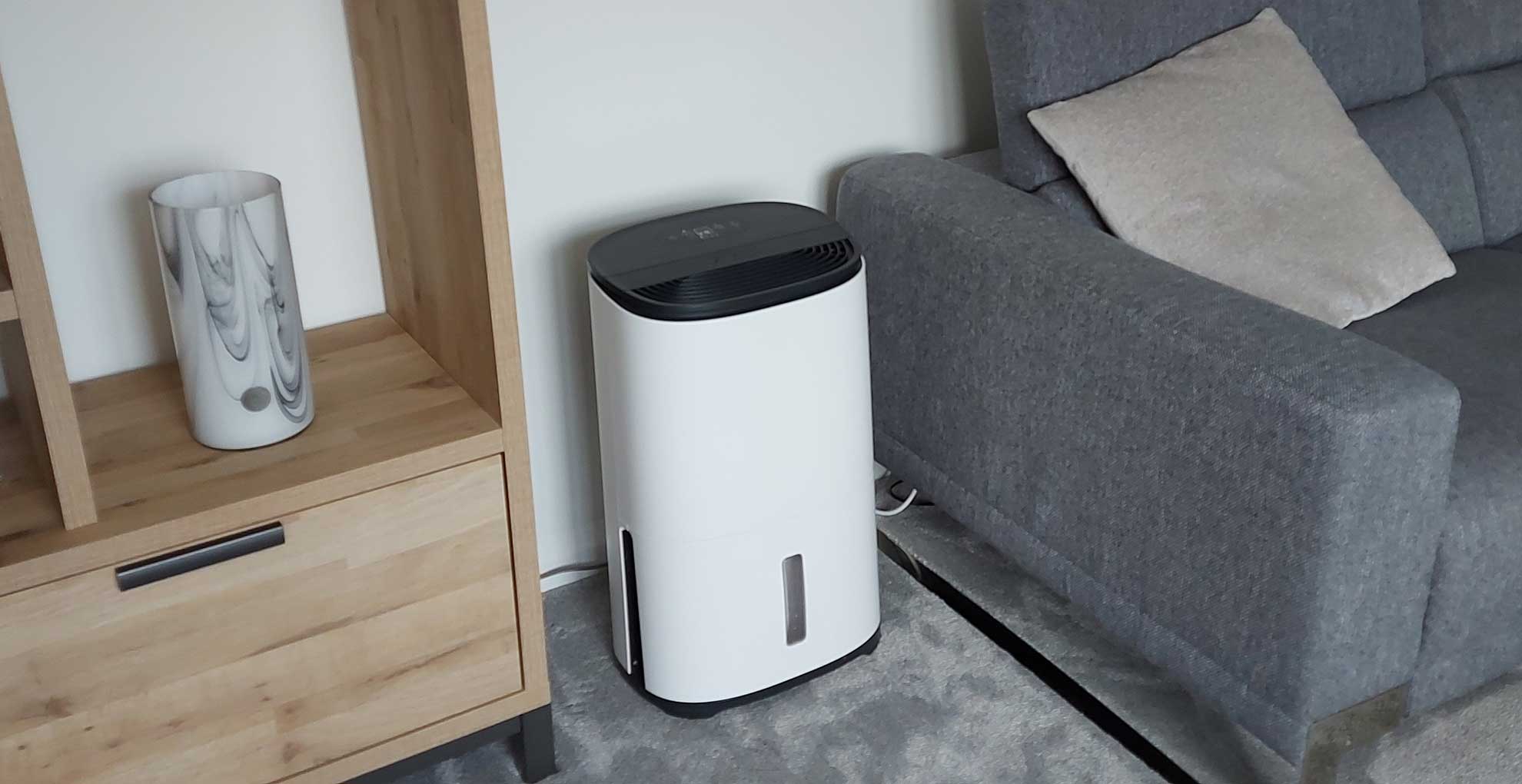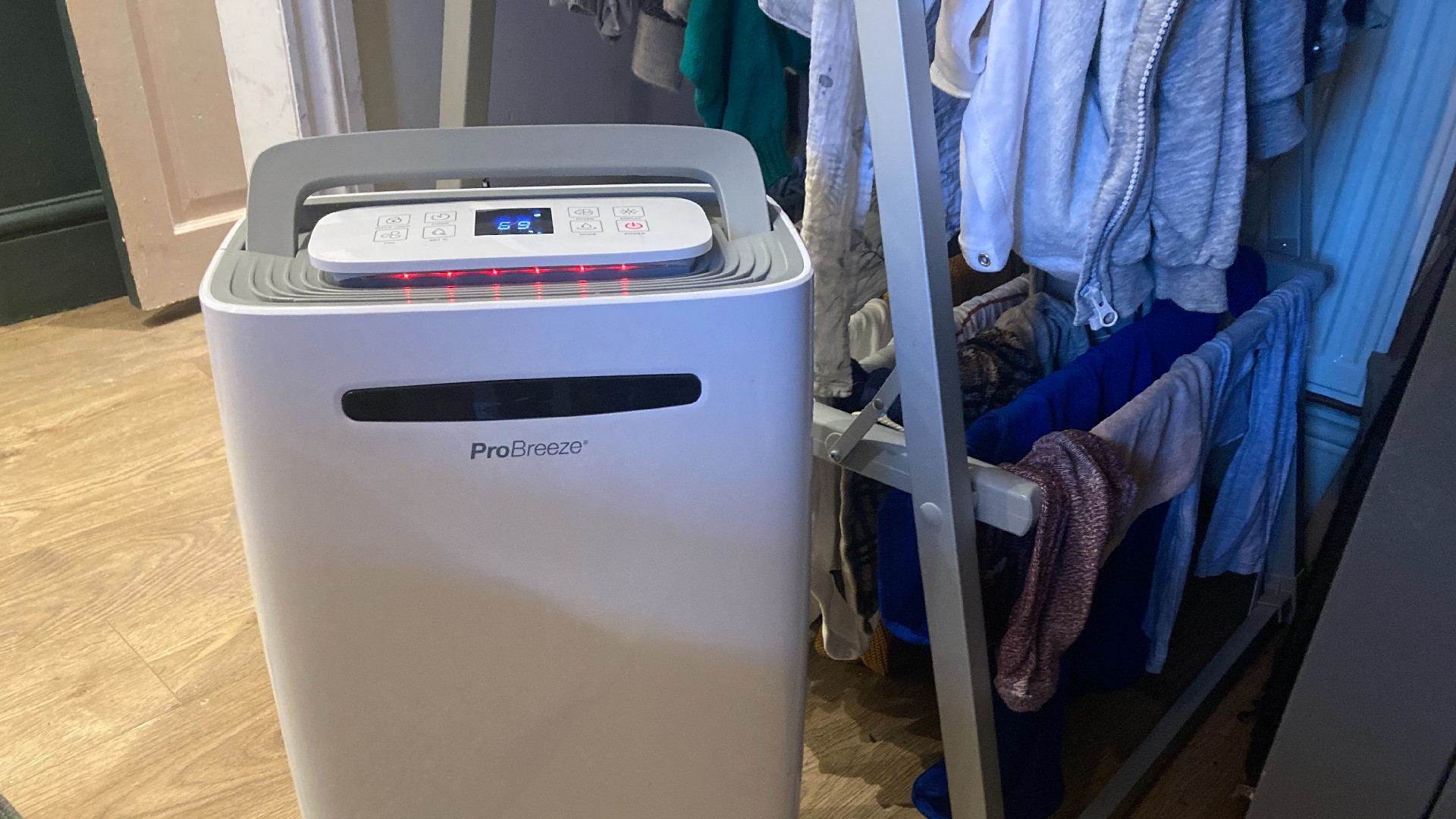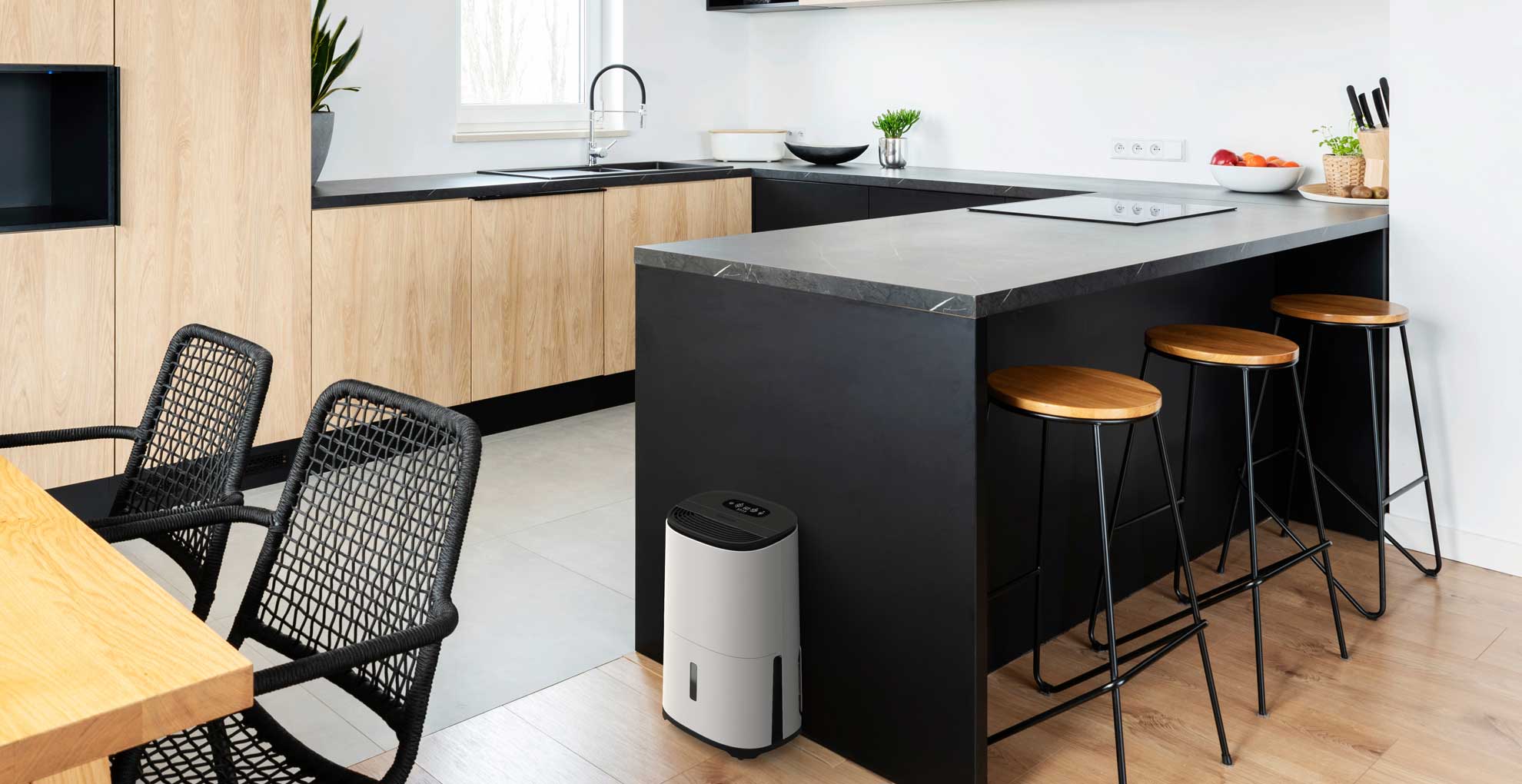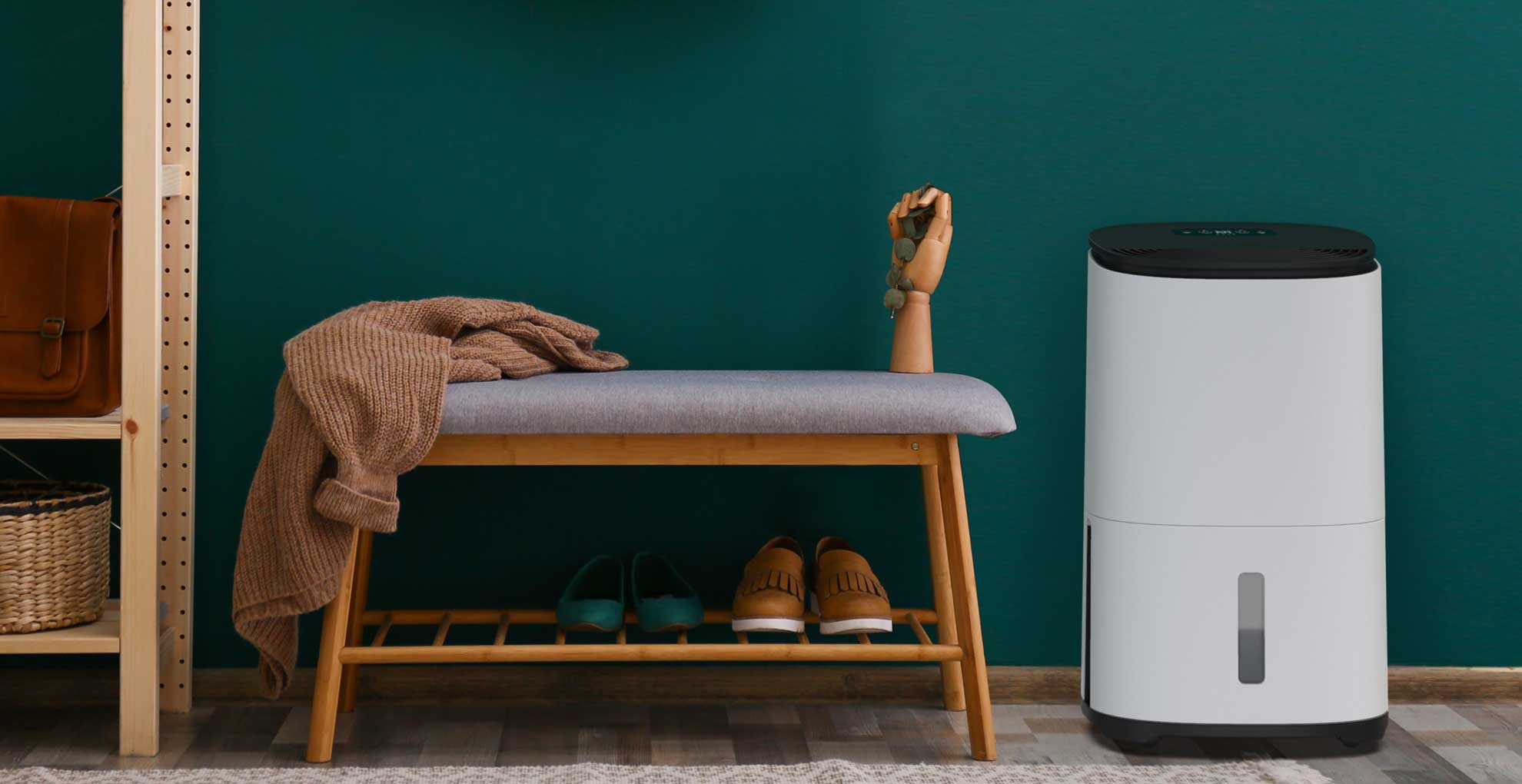How does a dehumidifier work and what are the benefits of owning one?
As the home appliance on everyone's wish list, we ask how a dehumidifier works and how could our homes benefit from one? An expert explains all


Dehumidifiers are one of the most sought-after appliances for homes right now, but why all the hype? We ask an expert to explain how a dehumidifier works. And outline the benefits and disadvantages of owning one.
The best dehumidifiers are celebrated as the promising remedy to help homes cope with the current cold and energy crisis, helping to extract excess moisture from the air with reasonable running costs.
Resisting the temptation to crank up the heating right now means condensation on windows and dampness can all worm their way into our living spaces, causing mould, prompting paint to start peeling despondently away from walls and giving rooms a very unpleasant musty odour. That’s before even going into the health risks associated with living in damp conditions.
To understand how a dehumidifier could be the best solution to combat all of the above, we explore exactly how this smart device works and the benefits of owning one.
How does a dehumidifier work?
"A dehumidifier removes moisture from the air preventing issues such as damp, mould, and condensation whilst maintaining a healthy relative humidity level in your home," explains Chris Michael, managing director of leading dehumidifier manufacturer Meaco.
"Removing excess moisture from the air can make a significant difference to your life. Too much moisture in the air means more likelihood of dampness and mould - anyone who has experienced condensation on windows or mould on bathroom tiles can relate to this. Using a dehumidifier means you can be in complete control of moisture levels, helping to reduce those problems and also giving you a better quality of life indoors."

Chris Michael is the expert co-founder of Meaco. Since its launch in 1991, Meaco has become a leading UK provider of air treatment products and the brand’s products have won a wealth of industry and design awards internationally.

What are the benefits of owning a dehumidifier?
Now we know how a dehumidifier works, removing excess moisture in the air we look to understand exactly how that is beneficial within our homes. Here are the many dehumidifier benefits and advantages that make this such a valuable investment for the well-being of your home.
Sign up for the woman&home newsletter
Sign up to our free daily email for the latest royal and entertainment news, interesting opinion, expert advice on styling and beauty trends, and no-nonsense guides to the health and wellness questions you want answered.
1. Combating mould growth
Because the primary function is to remove moisture from the air and therefore reduce humidity in the home the obvious major benefit of using a dehumidifier is combating mould.
"Moisture is always in the air around us and not just created by drying washing indoors," Chris explains. "It comes from various daily household activities such as bathing, showering, cooking and even breathing. This is why many households struggled with dampness and mould even before they turned down the thermostat or stopped using a tumble dryer."
"A dehumidifier helps households by removing condensation, stopping mould from forming and preventing damp smells, mildew and damage to soft furnishings, which can be costly to repair or replace."
2. Improving general air quality
One of the main benefits of using a dehumidifier is how much it can help to improve the quality of the in your home.
"While dehumidifiers are generally built to help with damp problems, some dehumidifier brands now offer machines with built-in air purifiers too," Chris explains. "These dehumidifiers have a HEPA filter to help clean the air as it dries. The fine filter captures smaller particles like pollen, allergens, and toxins, and means there is no need to purchase both a dehumidifier and an air purifier, saving on household expenditure, space, and running costs."
Not to be confused with the best air purifiers, because how an air purifier works is different from that of a dehumidifier – a dehumidifier is better for improving air quality in a home that struggles with excess moisture and dampness.
"A dehumidifier removes excess moisture that can adversely affect health and your home environment," says Chris. "It helps by removing and preventing damp problems and makes the air healthier to breathe."
3. Drying laundry indoors

If you're looking for better results when drying clothes indoors this benefit will be music to your ears. Removing the excess moisture from the air makes dehumidifiers very effective at drying clothes and laundry inside the home – speeding up drying times quite significantly, especially the models with a dedicated laundry mode.
"Not only do they dry laundry quickly, and at a low running cost, but they prevent the excess moisture created by the wet laundry from causing damp, mould, and condensation in your home," Chris explains.
Using a dehumidifier to help with drying clothes more efficiently is also a great way to stop mould in wardrobes, by ensuring all garments are completely dry.
4. Reducing humidity levels
"A dehumidifier is probably the quickest way to dry the air in a home. It’s a simple plug-and-play machine where you can set the desired humidity setting," explains Chris. "Many owners of dehumidifiers are surprised when they learn how high the humidity level was in their home, and notice an immediate difference from using one."
5. Affordability to run
With an awareness of energy usage, many of us ask how much it costs to run a dehumidifier. The good news is, it's an affordable amount.
"Dehumidifiers are affordable to run, with some costing as little as 5p/7.5 cents an hour to run*," says Chris. "They help to reduce energy bills because dry air is warmer, so the heating won’t need to work so hard to keep a home warm. Investing in an energy-efficient dehumidifier over other similar products on the market can save households on yearly running costs."
"Some dehumidifiers have further energy-saving features, such as a dedicated laundry mode where the machine runs for up to six hours, and then switches itself off," adds Chris. "Some also use a humidistat which means the dehumidifier switches itself off when the target humidity is reached, and only switches on again if it detects a humidity increase."
*A dehumidifier that can extract up to 12 litres a day, with a wattage of 151w (0.151 kWh) would cost just 5p an hour based on the October 2022 price of 34p per kWh per hour.

6. Keeping a house warm
Not only do the best dehumidifiers tackle dampness, but they can also help our heating systems work more efficiently because as previously stated dry air is much easier to heat than humid environments. Therefore by using a dehumidifier, you're already a step closer to keeping a house warmer in winter.
However, keep in mind certain dehumidifiers are more beneficial than others for heating a room. "A compressor dehumidifier only changes the temperature of the air by 1-2°C as it passes through," Chris explains. "This means they have no real effect on the temperature of a room, but they are cheaper to run."
7. Long lasting results
When buying any expensive home appliance it's good to check the lifespan and maintenance involved because they will determine how much you're getting value for money. Cleaning a dehumidifier is easy and most filters don't need replacing – which would entail further costs.
"All dehumidifiers come with filters to prevent larger particles from entering the machine. The filters are often removable, so can be cleaned regularly, and are generally life-long, so never need to be replaced."
Any good review, such as our MeacoDry Arete One 10L dehumidifier review, will explain how long the warranty lasts for each particular machine.
What are the disadvantages of dehumidifiers?
For balance we feel it's only fair to explore the possible disadvantages, although we have to say they are all subjective – because ultimately the benefits far outweigh any cons.
1. Bulky in size

There is no getting away from the fact that all dehumidifiers are quite sizeable, even the most compact designs but that's because they have to be large enough to hold generous volumes of excess moisture.
This means that their presence is felt in any room where they are placed. This only really feels like a disadvantage if you can't hide it away and it takes over your small organized space and lets the decor down.
2. Not suitable for bathrooms
Due to being mains powered, it is not advisable to use an electrical dehumidifier in a bathroom environment.
“We don’t advise using a dehumidifier in the bathroom because it isn’t IP rated," says Chris, "but positioning a dehumidifier as close to the bathroom as possible with the door open still can help to reduce moisture quickly.”
If humidity is particularly bad in a bathroom with no windows or ventilation you may be better off seeking a moisture-absorbing device. These are still often called dehumidifiers because, in essence, they do the same thing, but they are not powered by electricity instead they use refillable moisture-absorbing crystals to extract the water from the air.
I can personally attest that these do work in significantly reducing the humidity because I sourced one after worrying that my bathroom only has a tiny window and no extractor fan. I bought one of the best-reviewed Amazon dehumidifier deals.
3. Some vary wildly in what they offer
"Not all dehumidifiers are the same price to purchase or to run and can come with different warranties. This means the benefits and disadvantages of any particular dehumidifier will generally come down to performance, features, the overall price of the dehumidifier for users (both initial and overall running costs), and how effective it is at fixing the problem it is intended for," explains Chris.
"With this in mind, it’s important to research running costs and warranties and compare with other machines with the purpose of the dehumidifier in mind to ensure it does the job, is built to last, and is as cost-efficient it can be."
"It’s important to buy the right dehumidifier for your needs, or you simply won’t get the desired outcome and you'll be disappointed," warns Chris. "To dry out a very damp room or house, households need to look at larger capacity machines to do the job. Indications of high humidity levels are condensation on walls, mold on furniture or clothes, or condensation or mold in multiple rooms."
What type of dehumidifier is best for different rooms?
"Desiccant dehumidifiers are best for colder rooms that are generally below 10°C, like a garage, shed, storeroom, or perhaps a conservatory or utility room with no heating," Chris explains. "Once a desiccant dehumidifier condenses the moisture in the air into water and collects it, warm air then passes into the room, so desiccants also act as a gentle heater."
"Desiccants are a good choice for rooms with temperatures 10-16°C too. Some consumers are choosing to use a desiccant dehumidifier in these situations as the bit of extra warmth from the dehumidifier is just enough to avoid turning the heating on, saving more money. Desiccant dehumidifiers produce air around 10-12°C warmer than the air in the environment."
"Any compressor dehumidifier will perform well in temperatures above 16°C, however larger compressor dehumidifiers will perform well in temperatures above 10°C. The warmer the room, the more moisture they will remove from the air. One 10 or 12-litre machine will dry a room, or work well for a flat or 1 to 2-bedroom house.
"A three-bedroom house or larger property would require a 20 or 25-litre machine, or work well if you need to dry washing frequently."
Knowing how this popular home appliance works allows you to better decide whether you should buy a dehumidifier to combat the humidity levels in your home.

Tamara is a highly experienced homes and interiors journalist with a career spanning over 22 years. Now the Lifestyle Editor of womanandhome.com, she previously spent 18 years working with the style teams at Country Homes & Interiors and Ideal Home. With these award-winning interior teams, she gained a wealth of knowledge and honed her skills and passion for styling and writing about every aspect of lifestyle and interiors.
A true homes and interiors expert, Tamara has been an ambassador for leading interior brands on multiple occasions, including appearing on Matalan’s The Show and presenting at top interior trend forecasting events such as the Autumn Fair and Spring Fair.
-
 Cherry blossoms aren't just blooming outside, they're springing up in our beauty bags too - here are 9 buys to embrace the soft trend
Cherry blossoms aren't just blooming outside, they're springing up in our beauty bags too - here are 9 buys to embrace the soft trendFrom delicate, floral fragrances to cherry blossom-powered skincare, the beauty world is besotted with the pink flower this spring...
By Naomi Jamieson Published
-
 Amanda Holden's gold choker necklace is the perfect jewellery to wear with collared shirts
Amanda Holden's gold choker necklace is the perfect jewellery to wear with collared shirtsFinding necklaces to wear with shirts can be tricky, but Amanda Holden has struck gold.
By Charlie Elizabeth Culverhouse Published